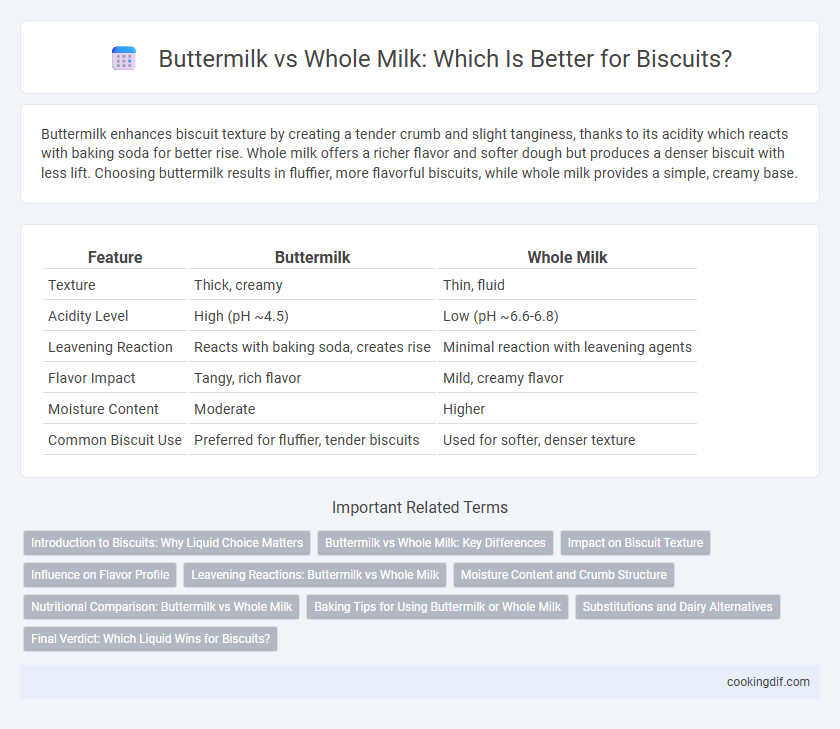Buttermilk enhances biscuit texture by creating a tender crumb and slight tanginess, thanks to its acidity which reacts with baking soda for better rise. Whole milk offers a richer flavor and softer dough but produces a denser biscuit with less lift. Choosing buttermilk results in fluffier, more flavorful biscuits, while whole milk provides a simple, creamy base.
Table of Comparison
| Feature | Buttermilk | Whole Milk |
|---|---|---|
| Texture | Thick, creamy | Thin, fluid |
| Acidity Level | High (pH ~4.5) | Low (pH ~6.6-6.8) |
| Leavening Reaction | Reacts with baking soda, creates rise | Minimal reaction with leavening agents |
| Flavor Impact | Tangy, rich flavor | Mild, creamy flavor |
| Moisture Content | Moderate | Higher |
| Common Biscuit Use | Preferred for fluffier, tender biscuits | Used for softer, denser texture |
Introduction to Biscuits: Why Liquid Choice Matters
Buttermilk enhances biscuit texture by reacting with baking soda to create a tender, flaky crumb, while whole milk provides a milder flavor and slightly denser structure. The acidity in buttermilk activates leavening agents more effectively, resulting in a lighter, fluffier biscuit. Choosing between buttermilk and whole milk significantly impacts the biscuit's rise, flavor depth, and overall mouthfeel.
Buttermilk vs Whole Milk: Key Differences
Buttermilk contains lactic acid that reacts with baking soda, creating a lighter, fluffier biscuit texture compared to whole milk, which lacks this acidic component. Whole milk contributes to a richer flavor and creamier crumb due to its higher fat content, while buttermilk imparts a slightly tangy taste and tender crumb. Choosing buttermilk results in biscuits with increased rise and moistness, whereas whole milk produces denser, more buttery biscuits.
Impact on Biscuit Texture
Buttermilk creates a tender, flaky biscuit texture due to its acidity, which helps activate baking soda and tenderize gluten, resulting in a lighter crumb. Whole milk, lacking acidity, produces a denser and softer biscuit with a less pronounced rise. The choice between buttermilk and whole milk significantly influences moisture retention and crumb structure in biscuit recipes.
Influence on Flavor Profile
Buttermilk imparts a tangy, slightly acidic flavor to biscuits, enhancing their depth and complexity, while whole milk provides a milder, creamier taste that results in a softer, less pronounced flavor profile. The lactic acid in buttermilk reacts with baking soda to create a tender crumb and subtle sharpness, distinguishing the biscuit's taste. Whole milk's neutral flavor allows other ingredients like butter and flour to shine, yielding a more balanced and traditional biscuit flavor.
Leavening Reactions: Buttermilk vs Whole Milk
Buttermilk contributes more acidity than whole milk, which enhances the leavening reaction by reacting with baking soda to produce more carbon dioxide, resulting in fluffier biscuits. Whole milk, having lower acidity, relies more on baking powder for leavening, offering a milder rise and denser crumb compared to buttermilk-based doughs. The acidic nature of buttermilk also tenderizes gluten strands, improving biscuit texture and rise through more effective gas retention during baking.
Moisture Content and Crumb Structure
Buttermilk contains higher acidity and slightly less moisture than whole milk, which enhances gluten development and results in a tender, flaky crumb structure in biscuits. The lower moisture content in buttermilk helps create a lighter, airier texture by reducing dough hydration, while whole milk's higher moisture yields a denser, softer crumb. Choosing buttermilk over whole milk optimizes biscuit moisture regulation, improving flakiness and overall crumb tenderness.
Nutritional Comparison: Buttermilk vs Whole Milk
Buttermilk contains fewer calories and less fat than whole milk, making it a lower-calorie option for baking biscuits while still providing protein and calcium. It also offers probiotics that support digestive health, unlike whole milk, which has higher saturated fat content and slightly more natural sugars. Choosing buttermilk can enrich the texture and tang of biscuits while contributing beneficial nutrients with fewer calories.
Baking Tips for Using Buttermilk or Whole Milk
Using buttermilk in biscuit recipes enhances tenderness and creates a tangy flavor due to its acidity, which reacts with baking soda to produce a fluffier texture. Whole milk provides a milder taste and richer fat content, contributing to a soft crumb but less rise compared to buttermilk. For optimal biscuits, substitute buttermilk when a lighter, tangier result is desired, or use whole milk for a denser, creamier biscuit.
Substitutions and Dairy Alternatives
Buttermilk provides acidity that reacts with baking soda to create fluffy biscuits, while whole milk offers a milder taste and less tender crumb. For substitutions, adding 1 tablespoon of lemon juice or vinegar to 1 cup of whole milk mimics buttermilk's acidity, enhancing rise and texture. Dairy alternatives like almond or oat milk can replace whole milk, but incorporating a tablespoon of acid helps replicate buttermilk's chemical properties in biscuit recipes.
Final Verdict: Which Liquid Wins for Biscuits?
Buttermilk is the preferred liquid for biscuits due to its acidic properties, which react with baking soda to create a tender, flaky texture and a subtle tangy flavor. Whole milk can produce soft biscuits but lacks the same chemical reaction that enhances rise and lightness. For bakery-quality biscuits with optimal crumb and flavor, buttermilk consistently delivers superior results.
Buttermilk vs whole milk for liquid Infographic

 cookingdif.com
cookingdif.com